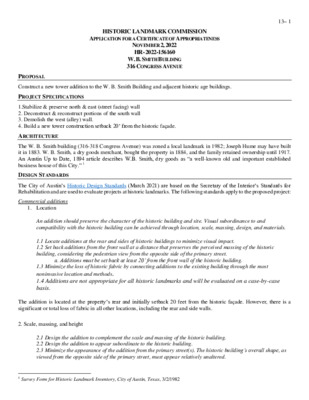13.0 - 316 Congress Ave — original pdf
Backup

13– 1 HISTORIC LANDMARK COMMISSION APPLICATION FOR A CERTIFICATE OF APPROPRIATENESS NOVEMBER 2, 2022 HR- 2022-156160 W. B. SMITH BUILDING 316 CONGRESS AVENUE PROPOSAL PROJECT SPECIFICATIONS Construct a new tower addition to the W. B. Smith Building and adjacent historic age buildings. 1.Stabilize & preserve north & east (street facing) wall 2. Deconstruct & reconstruct portions of the south wall 3. Demolish the west (alley) wall. 4. Build a new tower construction setback 20’ from the historic façade. ARCHITECTURE The W. B. Smith building (316-318 Congress Avenue) was zoned a local landmark in 1982; Joseph Hume may have built it in 1883. W. B. Smith, a dry goods merchant, bought the property in 1884, and the family retained ownership until 1917. An Austin Up to Date, 1894 article describes W.B. Smith, dry goods as “a well-known old and important established business house of this City.” 1 The City of Austin’s Historic Design Standards (March 2021) are based on the Secretary of the Interior’s Standards for Rehabilitation and are used to evaluate projects at historic landmarks. The following standards apply to the proposed project: DESIGN STANDARDS Commercial additions 1. Location An addition should preserve the character of the historic building and site. Visual subordinance to and compatibility with the historic building can be achieved through location, scale, massing, design, and materials. 1.1 Locate additions at the rear and sides of historic buildings to minimize visual impact. 1.2 Set back additions from the front wall at a distance that preserves the perceived massing of the historic building, considering the pedestrian view from the opposite side of the primary street. a. Additions must be set back at least 20’ from the front wall of the historic building. 1.3 Minimize the loss of historic fabric by connecting additions to the existing building through the most noninvasive location and methods. 1.4 Additions are not appropriate for all historic landmarks and will be evaluated on a case-by-case basis. The addition is located at the property’s rear and initially setback 20 feet from the historic façade. However, there is a significant or total loss of fabric in all other locations, including the rear and side walls. 2. Scale, massing, and height 2.1 Design the addition to complement the scale and massing of the historic building. 2.2 Design the addition to appear subordinate to the historic building. 2.3 Minimize the appearance of the addition from the primary street(s). The historic building’s overall shape, as viewed from the opposite side of the primary street, must appear relatively unaltered. 1 Survey Form for Historic Landmark Inventory, City of Austin, Texas, 3/2/1982 2.4 Additions are subject to a 20’ setback. They may be cantilevered 5’ towards the front wall but may not extend closer than 15’ behind the front wall. The cantilevered portion must begin above the historic building’s roof: a. At least 2 times the height of the historic building, for buildings that are one or two stories high. b. At least 1 time the height of the historic building, for buildings that are more than two stories high. 2.5 Match floor-to-floor heights as closely as possible with an adjacent historic building, if extant. Other Regulations: Buildings in the Congress Avenue combining district must be at least 30’ high and no taller than 90’ high. This applies to new buildings within 60’ of the west side of Congress Avenue and within 40’ of the east side of Congress Avenue. See regulations for the Congress Avenue (CA) combining district for more information. 13– 2 The addition is not subordinate and doesn’t complement the historic building. The additional alters the shape of the entire block. Congress Avenue combining district prohibits buildings over 90 feet in height. 3. Design and style, and 4. Roofs, and 5.Materials 3.1 Design proportions and patterns such as window-to-wall area ratios, floor-to-floor heights, fenestration patterns, and bay divisions to be compatible with the historic building. 3.2 Take cues for design elements and patterns from the historic building. 3.3 Do not replicate the design or details of the existing building to a degree that the addition might be mistaken as historic. 3.4 No particular architectural style is required for addition design. Designs in both traditional and contemporary styles can successfully achieve compatibility and differentiation with historic buildings. 3.5 The historic primary entrance must remain the most prominent. 3.6 If windows on an addition will be visible from a primary street, use windows that are compatible with those on the historic building in terms of fenestration pattern, size, configuration, and profile. Elevations and materials have not been provided. However, preliminary renderings indicate an initial setback from the historic façade of 20’. Sites and streetscapes 5. Sidewalks, driveways, and parking The project calls for subterranean parking beneath the W.B. Smith building. The proposed parking plan may adversely affect the historic landmark. Summary The project does not meet the applicable standards. COMMITTEE FEEDBACK Implement a deeper setback. Do not demolish the rear or side portions of landmark structures. Restore or incorporate adjacent buildings. New construction must be subordinate to the landmark buildings on the block, including the adjacent Koppel building. Retain streetscape, setback and height, massing, and fenestration patterns. STAFF RECOMMENDATION Postpone to December 14th, 2022, and refer to the next upcoming Architectural Review Committee meeting to allow the applicant time to provide additional materials, including elevations and material details, and to comply with the Citywide Historic Design Standards. LOCATION MAP 13– 3 PROPERTY INFORMATION Photos 13– 4 Congress facing façade of 316-318 Congress Avenue 13– 5 Aerial view of Congress depicting 316 Congress Loopnet.com, 2022 13– 6 Front facing ground level façade of 316-318 Congress Avenue Loopnet.com, 2022 13– 7 Rear and Side wall of 316 Congress Loopnet.com, 2022 13– 8 Lot lines for 316 & 318 Congress, Property Profile (austintexas.gov), 2022